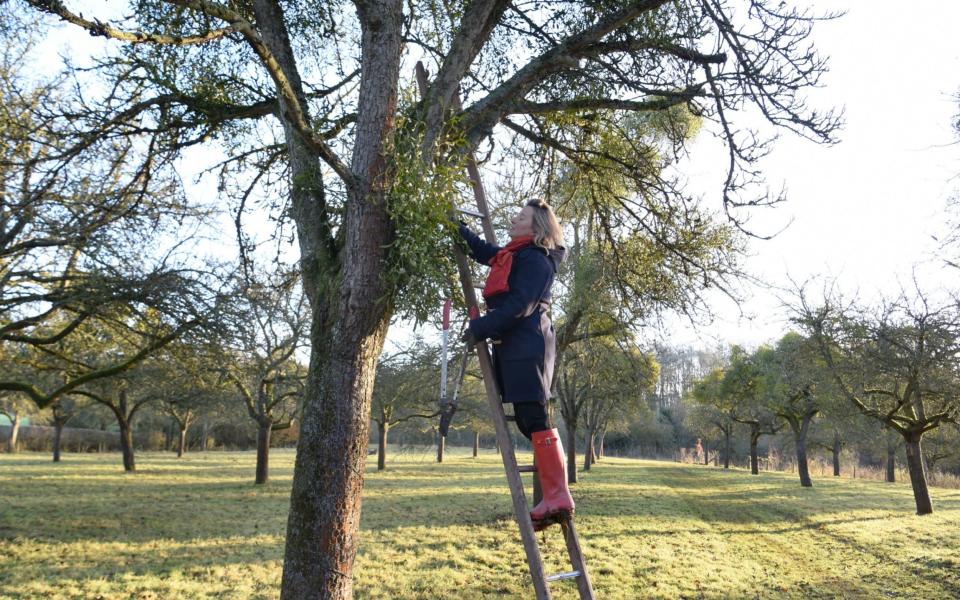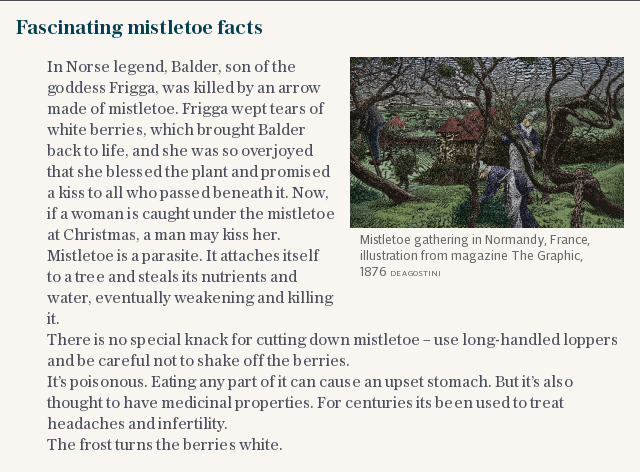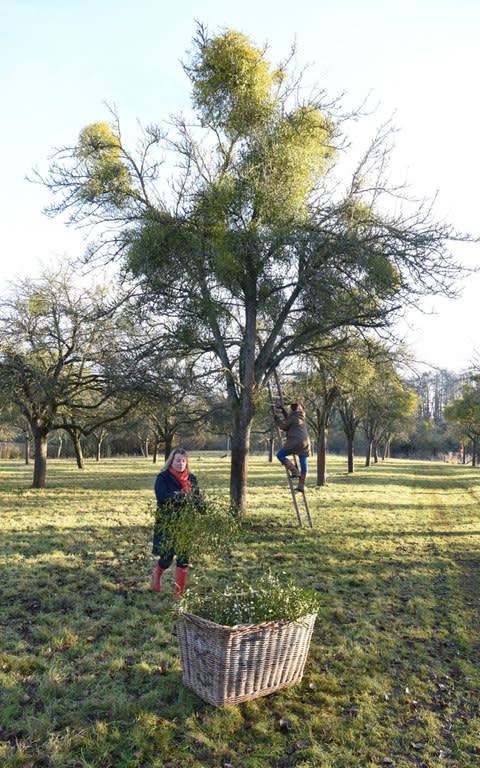Christmas decorations that grow on trees: join the mistletoe harvest in Herefordshire

Sunlight is streaming through the orchard on Netherwood Estate in Herefordshire and Peta Darnley is high up in an apple tree proffering an enormous ball of mistletoe. “It’ll go straight into a large box to be sent to one of our customers,” she explains, as she climbs down the ladder and places it in a wicker basket.
The last of the morning’s frost clings to the grass and sheep wander between the trees, which were planted by Darnley’s grandfather-in-law 70 years ago and are all laden with mistletoe. “It seems to love heritage fruit trees – and because we send it straight out, it’s far fresher than the mistletoe in shops,” she continues.
Given the volume of mistletoe here at Netherwood, it is no wonder Darnley decided to start selling it online last year. In this orchard alone it is growing in at least 100 apple trees and it is equally abundant in six larger orchards around the 1,200-acre estate. “It also grows in the poplars, but their height makes it trickier to reach,” Darnley explains.

Why mistletoe grows so abundantly in this part of the world is unknown, but the nearby town of Tenbury Wells, on the border of Shropshire, Herefordshire and Worcestershire, is home to Britain’s largest wholesale mistletoe markets each November and December. Darnley puts it down to wet and mild weather and the prevalence of older varieties of fruit tree, although this doesn’t explain why there is more mistletoe here than, say, Devon.
“I tentatively mentioned our mistletoe in a newsletter last December, about a week before Christmas, and had an extraordinary response,” she says. “This year we’re being more organised about it and can supply it with ribbons to arrive on a set date.”
In her red wellies and duffel coat, zooming around the estate on a quad bike with her three dogs, it is hard to believe that Darnley used to work in advertising and then for the BBC in London. Her husband, Ivo, who inherited Netherwood when his father, the 11th Earl of Darnley, died in June, still works as a fund manager and lives in London during the week.
“My friends thought I was nuts when I took over from my father-in-law 10 years ago but it made sense for it to be me rather than Ivo,” she says. “Both of us had fathers who came to farming when they were 30 and retreated from the world. He loves it here but he didn’t want that for himself.” Ivo, she says, would not have married her if he didn’t think she was up to running an estate.

“It’s amazing how suited women are to running farms and estates like this. I’m not great at driving a tractor but I have lots of other skill sets that come in useful. Until the Seventies, most of the jobs on a farm were manual labour, but that has completely changed now everything has become mechanised.”
Still, it can’t have been easy to move to this remote corner of Herefordshire and take the reins – particularly with three young boys at her feet. They’re older now – Harry, 18, is on a gap year to do a ski season, and Edward, 14, and Alexander, 13, are at boarding school – but initially Darnley admits it was a juggle.
Thankfully, 16th-century Netherwood Manor, the birthplace of the Earl of Essex, favourite of Elizabeth I, was very liveable (particularly once she had reconfigured some of the space to accommodate a playroom) but she soon discovered that the farm was unsustainable as a business. “Back then 85 per cent of the income was from arable and sheep, which wasn’t working,” she says. “Neither were we making any money from selling our cider apples.”
The mistletoe business is one of Darnley’s many sidelines to make the farm more profitable. More than 50 per cent of the income is from hospitality thanks to two historic properties on the estate, both painstakingly converted into sizeable luxury holiday houses that rent out for up to £5,000 per week.
The Hyde, an Elizabethan hall house and one of the oldest vernacular residential properties in the country, has its own ride-on steam train – a curious remnant from a previous owner that has proved a successful selling point – while The Freeth, a pretty Georgian farmhouse that sleeps 18, has an indoor pool.

Darnley has an eye for fabrics, china and lighting: her guests were soon asking where she bought the ceramics, glassware and linen in the houses. This inspired Hyde Inside, her homeware business, with a range of her favourite china, furnishing, lights and candles. “With the uncertainties of farming more uncertain than ever, it’s about revitalising and reimagining the estate,” she says.
Her next project is under way, a converted farmyard with a restaurant (serving game from the estate’s shoot), a spa and a mixed-use office and conference studio. She also has her sights set on re-establishing the Elizabethan deer park and building a smokehouse.
Of course she can’t manage all this on her own. Her permanent staff now includes eight working mothers and four men, headed by Darnley’s “right-hand woman” Louisa Gregory Norton, who will turn her hand to anything, be it organising private chefs and a murder mystery for a house party or, as she is today, helping retrieve mistletoe.
The mistletoe business is a no-brainer. Mistletoe is propagated naturally by birds such as mistle thrush, blackcap and redwing, which eat the berries and spread the seeds by wiping their beaks on the bark of other trees (mistletoe berries are notoriously sticky). Darnley’s only costs, therefore, are picking it – which she’d have to do anyway as mistletoe steals nutrients from the trees – and sending it out; easy, given there’s already an infrastructure in place due to the homeware business. “We get so little money for the cider apples that this is a great way of benefiting the trees and creating an extra income stream,” she says.

At £40 a box, it’s not cheap, but Darnley, a Christmas aficionado, is not in the least surprised that so many people are placing orders. “If you're going to decorate, why not go all out? Our mistletoe balls are so much bigger than anything else you’ll find and they’re covered in berries.”
Each year, when the boys break up for the holidays, the family goes in to the woods to find their Christmas tree. “Of course it’s always too big, so if Ivo isn’t here to work the chainsaw, I spend hours trying to cut it up with a hand saw,” Darnley says.
Then they decorate it together with cheesy carols playing and the boys winding up their mother with their dubious taste. “I have some beautiful Viennese Christmas decorations from my great-great-grandmother but the children take great delight in hanging their own ghastly things just where I can’t reach them – it’s a stylistic tussle every year,” she admits.
She’ll decorate the kitchen table with holly and other evergreen foliage and hang giant Venetian baubles from the ceiling – along with an enormous cloud of mistletoe.
“We tend to go to town in quite a ridiculous way,” she concedes. “But then I’ve never been very good at doing things on a small scale.”

